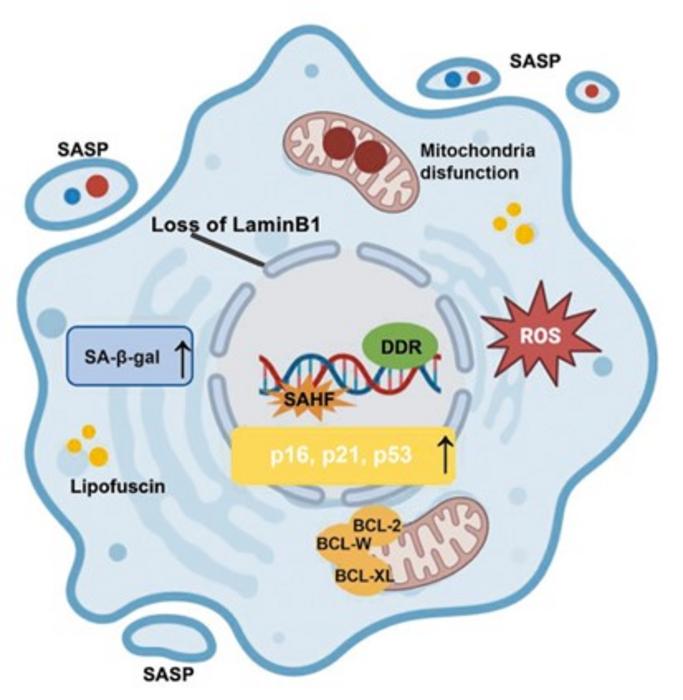Cellular senescence represents a fundamental biological phenomenon characterized by the irreversible arrest of the cell cycle, a process initiated in response to a variety of intrinsic and extrinsic stressors such as oxidative stress, DNA damage, and telomere shortening. Initially identified as a protective mechanism against cancer, the role of cellular senescence has evolved, revealing its complex contributions to aging and various age-related pathologies. The dual nature of senescence poses both protective benefits and pathological challenges, particularly in the context of liver health.
Liver cells, including hepatocytes, liver sinusoidal endothelial cells, and Kupffer cells, are significantly affected by the senescence process. When these liver cell types become senescent, they transition to a state associated with the senescence-associated secretory phenotype (SASP), characterized by the secretion of pro-inflammatory cytokines, chemokines, and other bioactive factors. This SASP can induce chronic inflammation, alter tissue microenvironments, and disrupt normal cellular functions, thus fostering a cycle of tissue damage and maladaptive repair processes. The accumulation of senescent cells in the liver correlates with chronic liver diseases, including non-alcoholic fatty liver disease (NAFLD), liver fibrosis, cirrhosis, and hepatocellular carcinoma (HCC).
In particular, senescent hepatocytes have been implicated in the progression of metabolic dysfunction-associated liver disease (MASH). The ongoing research underscores the importance of recognizing the markers of senescence, such as p16INK4a and p21CIP1, as key players in the metabolic dysregulation observed in liver pathology. Elevated levels of these proteins contribute to mitochondrial dysfunction and reactive oxygen species (ROS) accumulation, which further exacerbate the liver’s inflammatory state and ultimately impair its regenerative capabilities.
Chronic liver conditions marked by senescent cell accumulation can result in complex environments ripe for fibrogenesis, where activated hepatic stellate cells (HSCs) contribute to excessive extracellular matrix deposition. The process transforms normal hepatic architecture, leading to fibrosis and, in severe cases, cirrhosis. Additionally, the pro-inflammatory milieu generated by senescent cells can facilitate tumorigenesis, with advanced liver diseases frequently culminating in HCC.
A recent study led by a team of researchers, including Dr. Lin Wang from Xi-Jing Hospital in China, comprehensively examined the evolving understanding of senescence in liver health. While acknowledging the protective roles senescence plays in halting the progression of potentially cancerous cells, the study revealed that chronic senescence leads to persistent inflammatory states, which serve as precursors for increased fibrosis and cancer incidence. This nuanced understanding highlights why targeted therapeutic approaches may be essential for mitigating the adverse effects of senescence in liver pathology.
Experts, including Dr. Lee, who is a lead author on the study, have expressed the critical need for further investigation into the mechanisms driving cellular senescence and its interplay with liver disease. Recent studies have indicated a direct link between hepatocyte senescence and the development of liver cancer, reinforcing the notion that these age-associated cellular changes are not purely passive phenomena but active contributors to disease pathology.
The exploration of senolytic therapies has emerged as a hopeful frontier in addressing the challenges posed by senescence in liver disease. These therapies aim to selectively eliminate senescent cells from tissues, thus potentially reversing or halting the pathological processes they drive. Promising compounds, such as dasatinib and quercetin, have demonstrated efficacy in preclinical models, providing insight into how rejuvenating cellular contexts may pave the way for innovative treatments for chronic liver diseases.
Ongoing clinical trials focusing on the combination of dasatinib and quercetin mark an optimistic step toward the realization of these senolytic therapies in human medicine. If successful, these treatments could result in significant advances in how chronic liver diseases are conceptualized and managed. The challenge remains, however, in understanding the safety profile and long-term effects of such interventions.
As the research surrounding senescence develops, it is imperative to adopt a precision medicine approach tailored to the unique pathogenic pathways observed in different liver disease conditions. By elucidating the specific triggers of senescence within liver cell types, researchers aim to contextualize therapeutic interventions effectively. This will ultimately refine how we approach the treatment of chronic liver diseases, ensuring that strategies are individualized based on the metabolic and inflammatory landscape of each patient’s condition.
The growing body of evidence positions senescence as both a critical mediator of liver disease progression and a potential target for therapeutic intervention. Continued exploration into the underlying mechanisms of senescence will be vital in devising strategies that leverage its protective benefits while mitigating its detrimental impacts. With increasing awareness of the complexities surrounding cellular senescence, innovative avenues for treatment continue to emerge, providing hope for patients affected by chronic liver diseases.
As cellular senescence remains at the forefront of research in liver health, the convergence of biology, therapeutics, and clinical practice is set to reshape future interventions. Personalized approaches that recognize the dual nature of senescence may ultimately lead to breakthroughs in the management of liver diseases and enhance our understanding of aging and its associated challenges.
Subject of Research: Not applicable
Article Title: Navigating the complex role of senescence in liver disease
News Publication Date: 20-Dec-2024
Web References: Chinese Medical Journal
References: DOI: 10.1097/CM9.0000000000003439
Image Credits: Chinese Medical Journal
Keywords: Cellular senescence, liver health, hepatocytes, SASP, chronic liver disease, fibrosis, hepatocellular carcinoma, senolytic therapies, precision medicine, inflammation, metabolic dysfunction, liver regeneration.
Tags: Cellular senescenceChronic inflammationHepatic stellate cellsHepatocellular carcinoma (HCC)HepatocytesLiver diseaseLiver fibrosisLiver regenerationOxidative stressPrecision medicineSASP (senescence-associated secretory phenotype)Senolytic therapies





